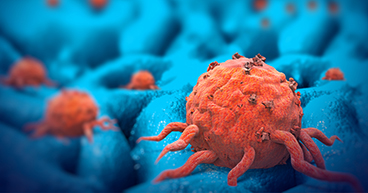
Like B-movie gangsters running from the cops, cancer cells sometimes go on the lam. They dodge capture (avoiding the surgeon’s scalpel) or death (surviving chemotherapy drugs) and find a hideout to cool their molecular heels until the heat is off. And when they emerge from their lair—months or years later—these cells may be more hardened than before and may establish metastatic tumors that are more resistant than the original cancer. In an article published in May, researchers at Duke University say they have identified in lab mice two proteins that allow hormone-positive breast cancer cells to escape into and latch onto bone marrow and hide from treatment. "Now we know how they are getting in," says Duke's Dr. Dorothy A. Sipkins, in an announcement of the findings. "We also identified an important mechanism that allows them to remain anchored in the bone marrow."
When breast cancer cells spread
Breast cancer cells are notoriously nomadic and are known to travel and settle in the bones, brain, liver and lungs. In some cases, the cancer cells may escape the primary tumor before the patient is diagnosed. Those cells may lay dormant or grow slowly in their hiding place, even as the patient goes through months of therapy and is then told doctors found no sign of cancer. "Because these cells are such slow growers, it may take a long time before you realize someone has developed metastatic disease," says Cynthia Lynch, MD, Medical Oncologist at our hospital near Phoenix.
The Duke researchers say some of these metastatic cells seek out the molecule E-selectin, which is often found in bone marrow. The cancer cells bind to E-selectin, allowing them to enter the marrow. There, another protein called CXCR4 allows the cells to nestle into the marrow, where they may hide for years. An E-selectin inhibitor called GMI-1271 may prevent the metastatic cells from entering the bone marrow. Researchers also believe the drug plerixafor (Mozobil®), which may be used to treat multiple myeloma and non-Hodgkin lymphoma, may act as a CXCR4 blocker and flush out hidden cells, exposing them to treatment. "We are hopeful that by understanding how these breast cancer cells migrate through the body and what their life cycle is, we can discover ways to make them more vulnerable and treatable,” says Dr. Sipkins, the main author of the research paper published in Science Transitional Medicine.
Evading treatment
This ability to hide and evade treatment makes it critical for breast cancer patients to stay on therapies such as tamoxifen (Nolvadex®) or a hormone-blocking aromatase inhibitor, even after scans indicate their body no longer has evidence of cancer, Dr. Lynch says. Dormant or slow-growing breast cancer cells don't always respond to chemotherapy, which may come with challenging side effects. And hormone therapy may require a decade-long commitment. "That's a long time to take a drug that also has side effects," she says.
Some patients experiencing treatment fatigue also find it difficult to stay on a cancer-therapy regimen. "Sometimes patients think because their prognosis is so good that they could maybe get away with not doing hormone therapy," she says. "But we see with hormone-positive breast cancer the risk of reoccurrence is just about the same in years five through 10 as it is in years one through five. I tell patients this, not to scare them, but because we have medicines that may decrease their hormone production and have a very strong impact on reducing the risk of reoccurrence."
In the search for better treatments and prevention strategies, scientists are learning more about how cancer grows and survives, even in the most hostile environments. This blog is an installment in an occasional series called “How does cancer do that?” designed to shine a spotlight on newly discovered cancer behaviors that add to our growing understanding.

